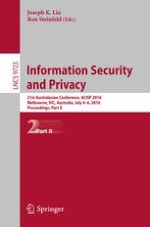2016 | OriginalPaper | Chapter
Partial Key Exposure Attacks on RSA with Multiple Exponent Pairs
Authors : Atsushi Takayasu, Noboru Kunihiro
Published in: Information Security and Privacy
Publisher: Springer International Publishing
Activate our intelligent search to find suitable subject content or patents.
Select sections of text to find matching patents with Artificial Intelligence. powered by
Select sections of text to find additional relevant content using AI-assisted search. powered by
